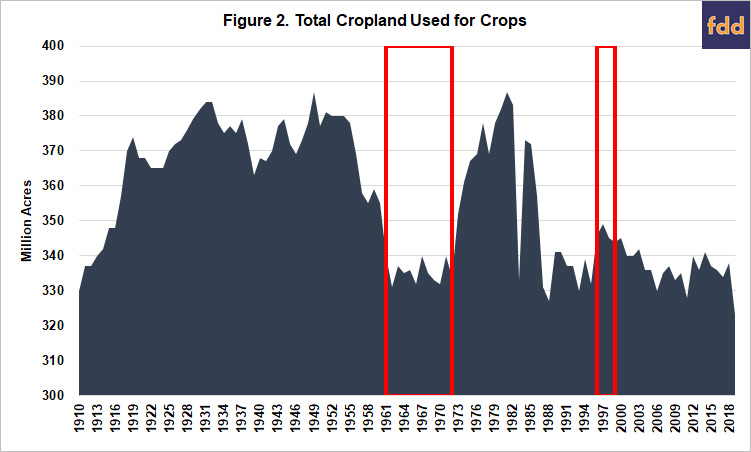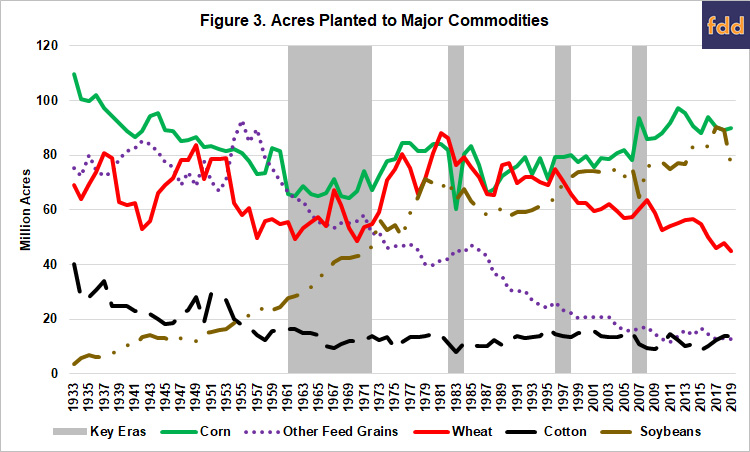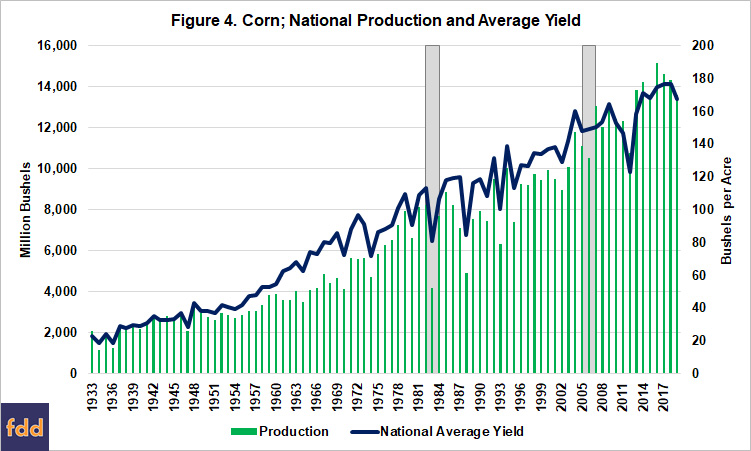JonSCKs - 2/17/2024 04:18
Maybe the USDA needs to consider rolling out a paid set aside.. if we are building grain stocks too much.. or a lot more land needs to be idled in the CRP?
We are already curtailing acreage. Besides set aside acreage is very inefficient because of "slippage"... the impact of acreage reduction programs on production is less than the number of idled would suggest, and not to mention the increase acres from other producing countries in response.
https://farmdocdaily.illinois.edu/2021/09/an-evolving-path-to-declining-us-crop-acres.htm
https://farmdocdaily.illinois.edu/2020/06/production-controls-set-aside-acres-part-1-reviewing-history.html

The data in Figure 2 generally aligns with the total acres planted to the major commodities discussed in an earlier article (farmdoc daily, April 9, 2020). One takeaway from Figure 2 is that initiating a set aside policy now would differ from earlier eras. Today any set aside policy would be applied to a much lower level of acres as compared to the late 1950s and the early 1980s; both eras when set aside policy reduced acres from an arguably excess situation. For example, total acres of cropland used for crops peaked at 387 million acres in 1981. By comparison, the average of these acres from 2007 to 2019 has been 335 million acres. The second area highlighted in Figure 2 covers the years 1996 to 1999, the first few years after decoupling payments in the 1996 farm bill. Notably, total cropland used for crops since decoupling in the 1996 Farm Bill peaked in 1997 at 349 million acres and has not returned to that level since. Congress decoupled payments in 1996 as a major reform to farm policy after 63 years, with a goal to avoid having federal payments distort planting decisions on the farm. It was considered a market-oriented response that would permit farmers to make planting decisions based on signals from the marketplace (e.g., prices). In the years since, Congress has also drastically revised the crop insurance program in 2000 and returned to price-based assistance programs in 2002. Figure 3 illustrates the total acres planted nationally to the major commodities as reported by USDA’s NASS Quick Stats database. Key eras are highlighted in Figure 3, the first corresponding to the early era of set aside acres as in Figure 2 (1961 to 1972). This era corresponds to reduced acreage in corn, but also covers a significant part of the steep decline in acres planted to the other feed grains (barley, oats, rye and sorghum). Planted acres around the heavy acreage reductions under the Reagan era PIK program in 1983 are also highlighted. The final two highlighted areas correspond to decoupling in 1996 and the initial years after that change in policy, as well as the initial years of the Renewable Fuels Standard (RFS) policy initiated by Congress in 2005 and increased in 2007. 
Figure 3 also emphasizes the acreage shifts since decoupling in 1996 as acres planted to soybeans exceeded acres planted to wheat. Onset of the RFS also appears to have contributed to a further decline in wheat acres. Since 2007, total acres planted to these commodities has averaged nearly 250 million acres; of those acres, corn and soybeans have averaged 170 million acres (68%). One takeaway is that any set aside acreage policy implemented in the near future is likely to be concentrated on planted acres for corn and soybeans. Figure 4 provides the final historical perspective in this discussion that also serves as a starting point for further analysis in future articles by illustrating total national production of corn and the national average corn yield from 1933 to 2019. It highlights one of the biggest challenges for efforts to control production through reducing or setting aside acres. Specifically, corn yields have experienced significant increases, outside of weather problems such as drought in 2012, and that trend for yields is helping to drive increased production. Increasing trends for yields would require larger acreage reductions to achieve supply reductions, a problem experienced throughout the history of production control and set aside policies. 
The onset of the RFS (2005 to 2007) is highlighted in Figure 4 because the years since it was created correspond with both increased acres planted to corn and increased yields to produce record levels of corn production (compare to Figure 3). Finally, the year 1983 is also highlighted because it corresponds to the PIK program’s drastic reduction in acres planted to corn. Total production in 1983 was about half of the average production in the five years prior (7.6 billion, 1978 to 1982) and the five years after (7.4 billion, 1984 to 1988). It was a year of drastic reductions in planted acres and a yield well below trend. A future article will take a deeper dive into 1983 to provide further perspective on this issue. ConclusionHistory demonstrates that difficult economic times in farming can drive demand for policies that seek to reduce or control supplies. Policies seeking to reduce acres and control supplies have been a consistent response to tough times. Acreage allotments were created in the Great Depression, the Soil Bank was created during a time of extraordinary surplus after World War II and the Korean War, in the midst of the technological revolution; set aside acres, PIK and CRP were all used in response to the economic crisis of the 1980s. The general goal through has been an effort to reduce acres in hope of helping to improve crop prices and farm income. A return to troubled times is currently revitalizing interest in set aside acreage policies and that interest is likely to grow if the challenges continue as expected for the foreseeable future. This article briefly reviews the history for set aside and acreage reduction policies to provide a starting point for further analysis. The goal of the discussion is to glean lessons from the past in order to apply them in the increasingly difficult discussions unfolding across the country. | 

 Have enough of your neighbors thrown in the towel so we can bottom? Market comments
Have enough of your neighbors thrown in the towel so we can bottom? Market comments